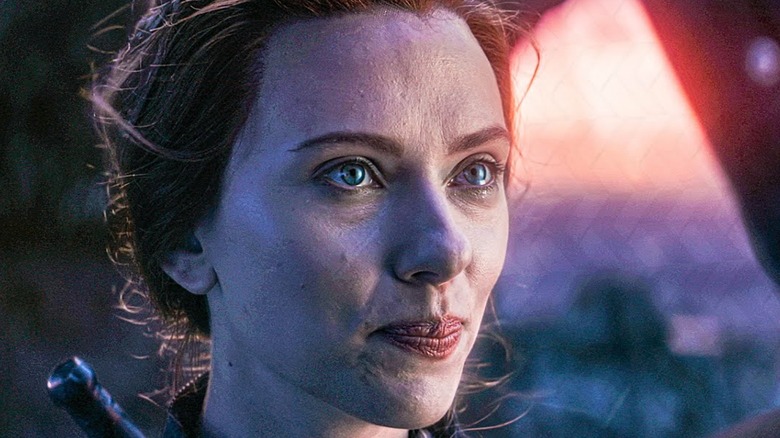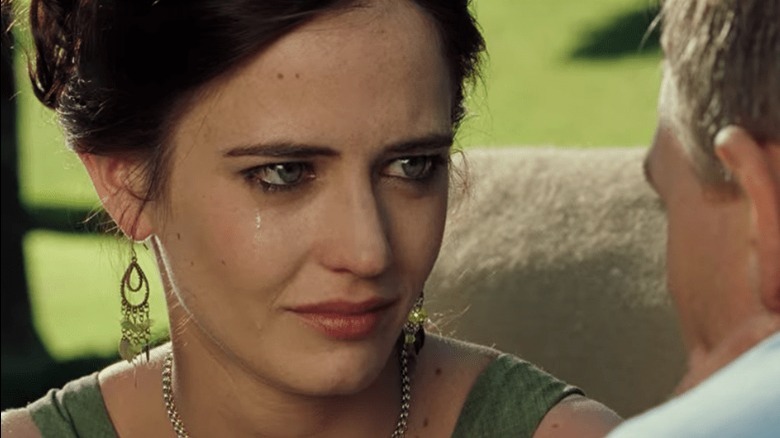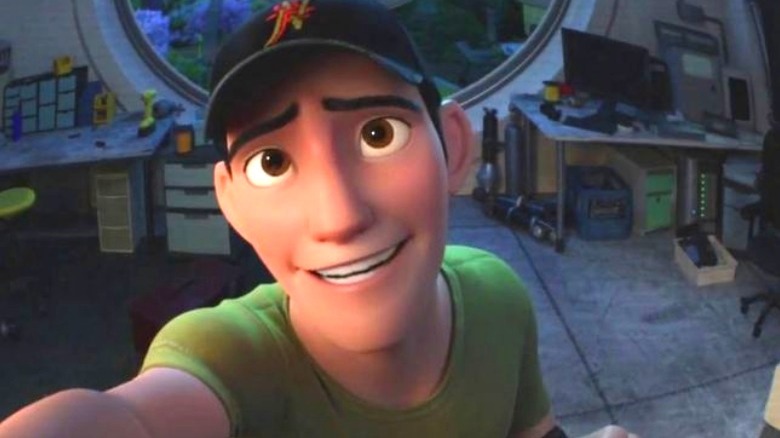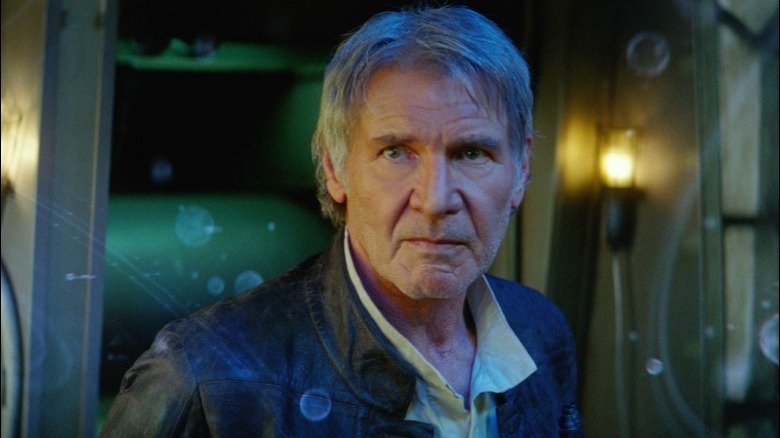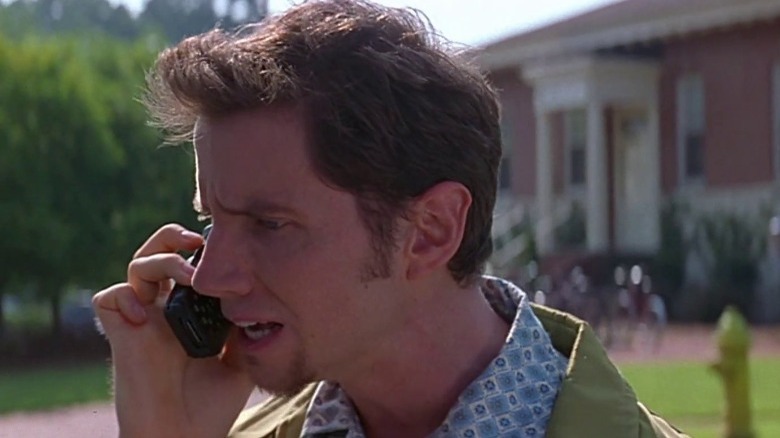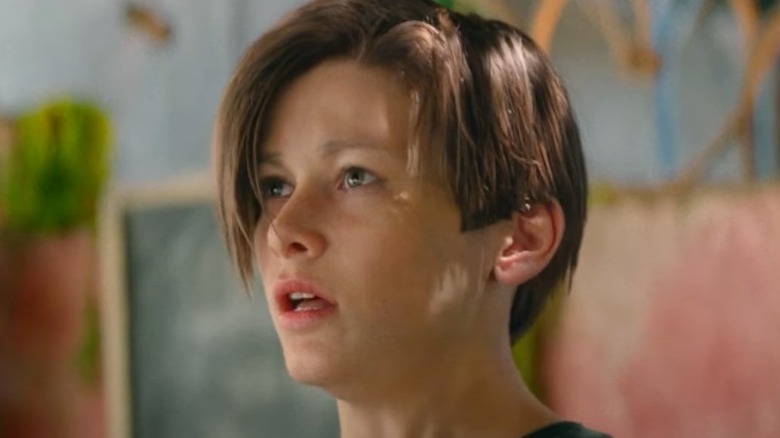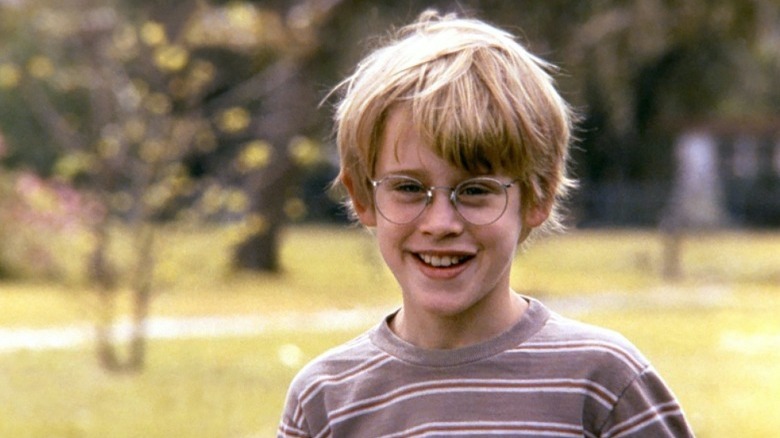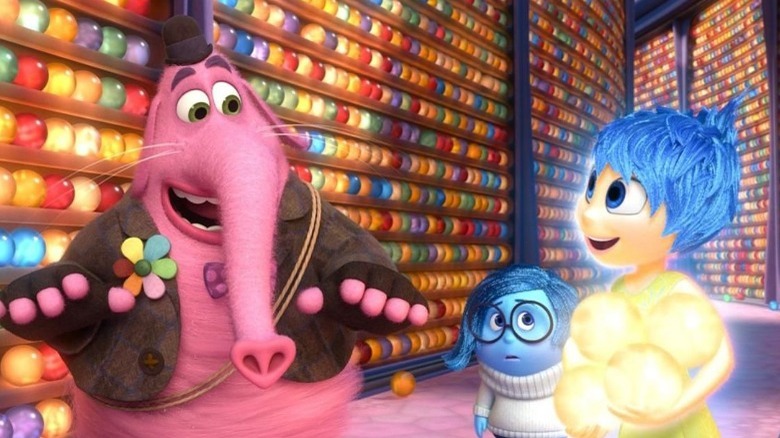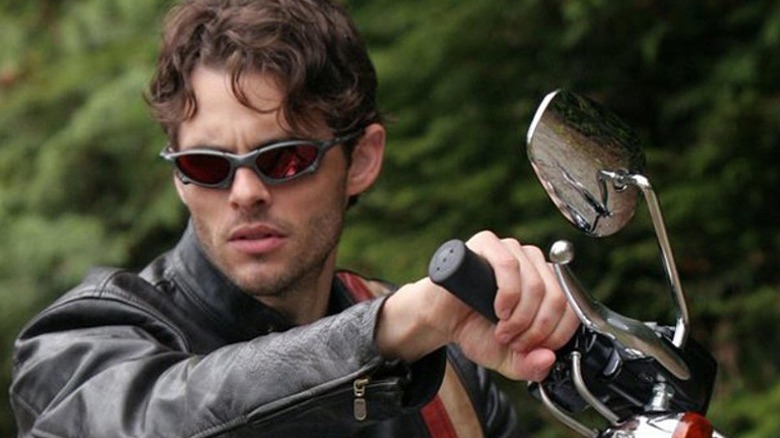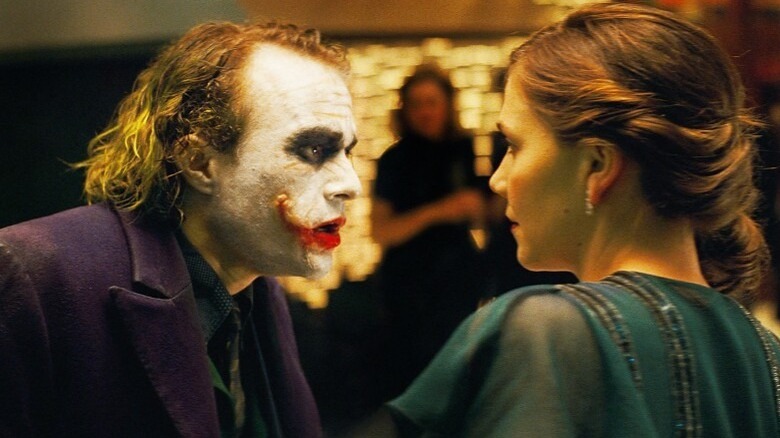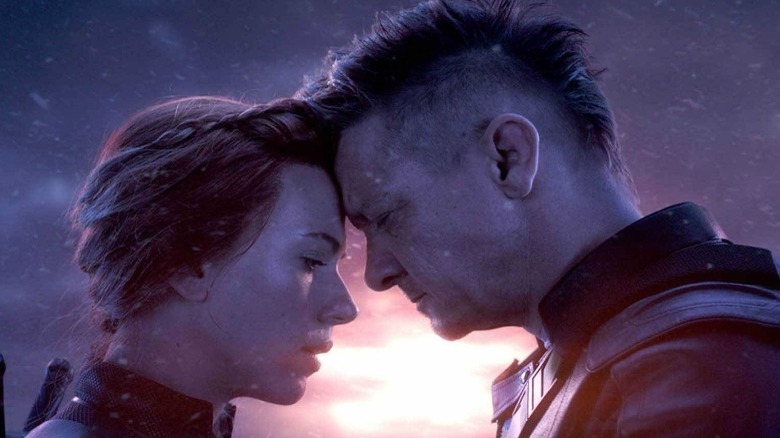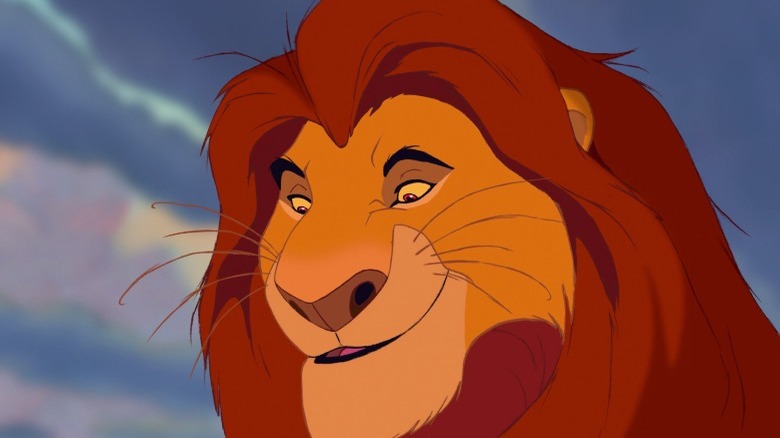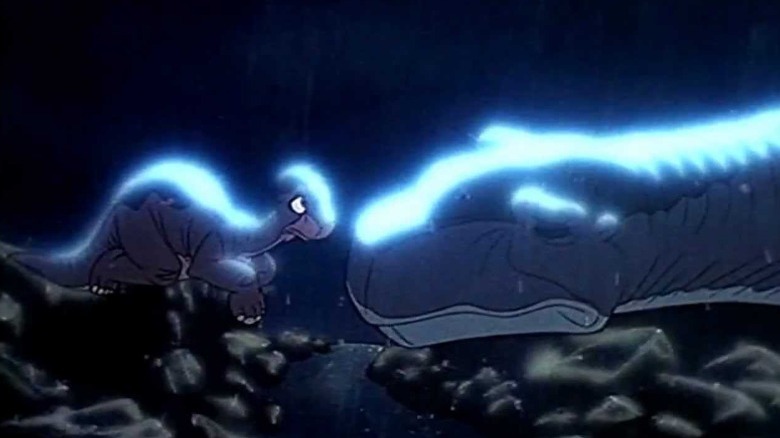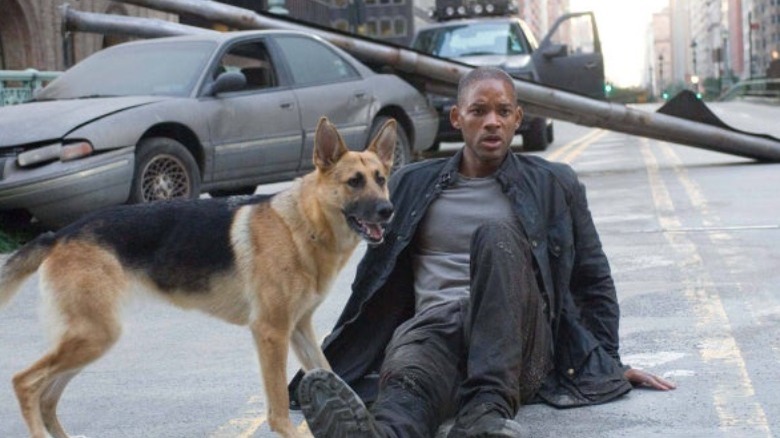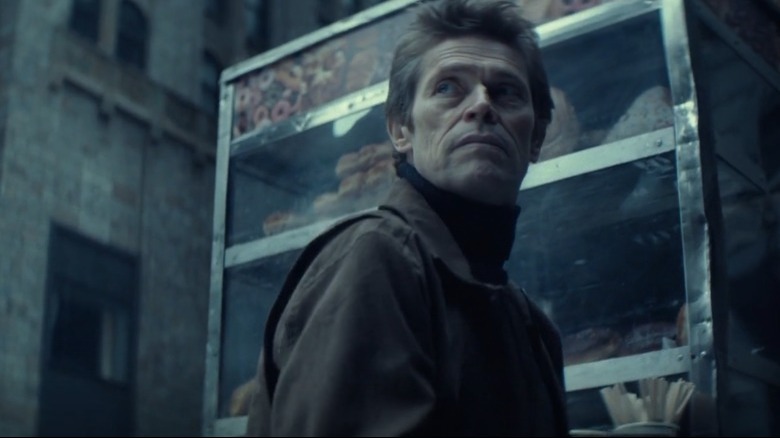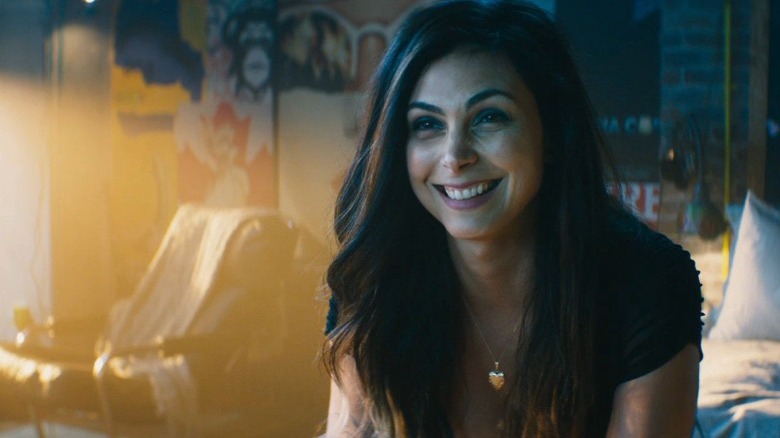Times Movie Characters Were Killed Just To Advance The Story
Crafting an engaging narrative is no simple task. Filmmakers, screenwriters, and novelists know that telling a story that conveys emotion and empathy for characters is difficult work that takes more than a splash of creativity. Sometimes, however, a story's pacing is disjointed and it's up to the author to inject a plot device to keep the ball moving and you — the spectator — engaged. One of the most utilized plot devices of all time is enacting the death of a pivotal character to either push the story forward or bolster the narratives behind other main characters.
Sometimes this narrative trope is seen as ineffectual when critics understand that the act is merely a contrivance to serve other characters. In these cases, a story in film or a novel can meet the harsh critique of reviewers labeling the work as "lazy." When it comes to women meeting an untimely demise so that the hero can complete a journey of self-discovery, the trope has even been given the term of "fridging" — a cliché feminists have railed against the comic book world for practicing, and deservedly so. Of course, there are times when the death of a beloved character is properly earned by the narrative despite its impact on the story. Regardless of the reason, there are countless films that have used this plot device to great effect. Let's take a look at some of the most prominent uses of major deaths in film that aided the story's progression.
Vesper Lynd (Casino Royale)
Daniel Craig's iteration of the famous suave British spy, James Bond, brought the character to new heights in the modern age. In the first film featuring Craig in the role, "Casino Royale," James thinks the unconscionable, leaving his service to MI6 and settling down with a woman he has deeply fallen for, Vesper Lynd (Eva Green). After successfully bankrupting the evil mastermind and terrorist Le Chiffre (Mads Mikkelsen) in a high-stakes poker game, Vesper is seemingly captured by Le Chiffre. Attempting to free her, Bond falls into Le Chiffre's clutches and is tortured. Bond is ultimately saved by a mysterious figure who kills Le Chiffre.
Following the fiasco, Vesper and James fall in love and spend quite a bit of time together. What James is unaware of is that Vesper was working for a handler by the name of Adolph Gettler who she had embezzled the winnings from the poker game for. Ultimately, she was being manipulated by other shadowy forces that Bond would uncover in future films. After Gettler comes for her, however, he throws her in a cage and drops it under water. Bond attempts to save her but Vesper resigns herself to death having left a note for him professing her love.
Vesper's death brought James back into the service as his anger fuels his need to dismantle corruption. Her death was once again used to manipulate Bond in "Spectre," as Ernst Stavro Blofeld (Christoph Waltz) tormented the agent with the idea that Blofeld ultimately orchestrated it. Spectre even attempts to kill Bond again in "No Time to Die" when he's visiting Vesper's grave site. Talk about a lasting impact.
Tadashi (Big Hero 6)
Disney's "Big Hero 6" is a Marvel property that adapted Hiro Hamada and his robotic pal Baymax for the big screen in computer-animated glory. Hiro spends his time using his smarts and talents to earn money illicitly by gambling on his own robotic creations in robot fights. His older brother, Tadashi, ultimately guides Hiro away from that path, hoping that his little brother can make something of himself. He takes Hiro to his school, the San Fransokyo Institute of Technology, where he introduces Hiro to his friends and peers alongside all of their accomplishments in the field of technology. Excited, Hiro joins the school. However, tragedy strikes when Hiro unveils his creation at a showcase. A fire starts and Tadashi runs back into the building attempting to save his mentor Professor Robert Callaghan. But Tadashi perishes in the fire.
At first, Hiro is consumed in his own grief, understandably. After interacting with Tadashi's healthcare robot Baymax, however, Hiro decides to investigate the fire, believing it wasn't accidental. He finds that a mysterious man has taken his microbot invention and mass-produced it. Hiro then joins forces with the students at the research lab to form an alliance of superheroes with abilities centered around their inventions to fight crime and pursue the shadowy man.
Tadashi's death not only leads Hiro to finding inspiration from his brother from beyond the grave, it also spurs Hiro and their friends at the lab into action to avenge Tadashi and stop the masked man's criminality from persisting.
Han Solo (Star Wars: The Force Awakens)
Perhaps one of the biggest shockers of "Star Wars: The Force Awakens" is the untimely death of one of the series' most beloved characters: Han Solo. To add insult to injury, Han doesn't even die in a blaze of glory fighting his way out of battle. Instead, he meets his end while unarmed at his own son's hands. Ben Solo, or Kylo Ren, as he is known in his angsty and emotionally-tormented adult years, must choose between his master, Supreme Leader Snoke, or his own father who he's been estranged from.
Killing his father was the only way Kylo could sever his connection to "the light" and fully embrace the dark side of the force. However, it's also a decision that would torment him in future films. Han would even appear to Kylo in the final film of the saga to offer him some sage advice. Ultimately, Kylo's decision to murder his father — in conjunction with the eventual death of his mother, General Leia Oregana — brought Kylo back to the light, a move he once attempted to prevent. In so doing, he aided Rey in her confrontation with the evil Emperor.
The real question, however, is what did the filmmakers hope to achieve with the death of Han Solo in "The Force Awakens?" Simply put, J.J. Abrams made it clear (via Entertainment Weekly) that he wanted the new villain to make a bold move that might actually cause him to be more monstrous than the legendary Darth Vader. So, in effect, Han Solo's death was to aid Kylo Ren's image as a villain. Got it.
Randy Meeks (Scream 2)
The brains behind "Scream" is none other than the super nerdy cinephile Randy Meeks (Jamie Kennedy). Without a doubt, Randy is the first to have cracked the code behind the patterned killings of the Ghostface-masked killer that stalked Woodsboro. "Scream" was essentially a fourth-wall-breaking horror film that recognized the tropes of its own genre, and Randy was the very person to bring those horror clichés to light. He understood that the killers were ultimately fans of the horror genre themselves and that certain patterns must be followed. For instance, those who fornicate or say, "I'll be back" are primed for a gruesome death.
In "Scream 2," Randy bites the dust rather early if only for a bit of shock value. Perhaps, one of the most interesting characters of the first film and a character destined for survival given his well-versed knowledge in the realm of horror tropes, Randy was lured and savagely killed in the back of a van by the killer. He was the first major death of the "Scream" franchise that involved a character from the original film. The filmmakers seemingly wanted to subvert expectations by removing Randy from the equation early, even if it made little sense given his nerdy expertise that'd still be utilized in future films via his own extended family or a recovered tape that he recorded. Randy's death only served to up the ante of the sequel without much consideration for the franchise's future.
John Connor (Terminator: Dark Fate)
"Terminator" is one franchise that has attempted multiple times to recapture the magic of James Cameron's first two films to little avail. "Terminator: Dark Fate" is the most recent film that meant to undo everything following the events of "T2" in favor of a new, proper threequel. In this movie, the filmmakers recreated Edward Furlong's likeness for John Connor in an opening sequence where a rogue terminator finds Sarah and John and executes the latter in broad daylight, despite the pair having prevented Judgement Day and Skynet's rise to power.
This move was an effort to wipe the slate clean. Basically, it felt like the filmmakers were saying, "Enough of the John Connor story." Despite this, the movie still brought Linda Hamilton back as Sarah Connor and Arnold Schwarzenegger as the aging T-800 that killed John in an effort to score fan service points while regarding the franchise's legacy. However, in trying to do something new, it ultimately told the same tired story of a new AI rising in Skynet's place and attempting to destroy humanity with machines. Only this time, John doesn't exist any longer as a revolutionary and new characters have taken up that mantle in the fight against this enemy known simply as Legion. A terminator is sent back in time to kill an important leader in the war against Legion, and another individual is sent to protect her. Does that sound familiar?
John's death simply made room to bring on new characters and rehash the "Terminator" story with a different coat of paint. Perhaps, if the franchise survives into the future, filmmakers will actually attempt to do something new with the narrative.
Thomas J. Sennett (My Girl)
The coming-of-age drama, "My Girl," tells the story of a young girl, Vada Sultenfuss (Anna Chlumsky), and her best friend Thomas J. Sennett (Macaulay Culkin). Vada is an average girl who enjoys getting into mischief with her best friend, Thomas. He's not very popular among Vada's peers, and he is allergic to just about everything. Regardless, he's kind and often demonstrates his care for Vada. One day, the two are out in the woods and spot a beehive. Thomas knocks it down and the two kids flee the angry swarm. Vada loses her mood ring as a result. Later, Thomas returns to the scene to find the mood ring. Tragically, the beehive is still very much occupied and Thomas is swarmed and killed by the bees.
This tragedy leads into the third act of the film which depicts Vada's grief over the incident. At first, Vada has difficulty even wanting to set foot outside of her room. However, she eventually attempts to flee from her sadness by actually running away. When she returns home, her family is elated and she bonds with her father and his girlfriend, two people who she had a strained relationship with recently. She is also finally able to accept her own mother's death. And Vada's connection with her friend beyond the grave enabled her to gain the emotional growth she needed to move forward.
Bing Bong (Inside Out)
Pixar knows how to tug at our heart strings; they've been doing it for decades. "Inside Out" presented a resonating look at the memories and emotional growth of a young girl named Riley (Kaitlyn Dias) who is coming of age. Inside, her feelings are represented by animated personifications of traditional emotions including Joy (Amy Poehler), Anger (Lewis Black), Disgust (Mindy Kaling), Sadness (Phyllis Smith), and Fear (Bill Hader). Joy struggles to keep Riley happy as the young girl enters her complicated teenage years. Joy and Sadness become separated from the group and must journey back to Riley's memory center.
During the journey, Joy runs into Bing Bong, Riley's old imaginary friend she used to pal around with when she was a young girl. After an attempt to jump over a chasm of forgotten memories, Bing Bong and Joy fall into the dark. In an effort to get out, Joy and Bing Bong use his magical ship to exit the chasm but can't quite make it. They try one last time and this time Bing Bong jumps out of the ship so Joy can make it. It's a noble sacrifice that likely made us all weep like babies as Bing Bong demonstrated his enduring love for a young girl who had long forgotten him. As he truly faded into obscurity, Joy was able to return to the memory center and help Riley sort out her feelings.
Cyclops (X-Men: The Last Stand)
"X-Men: The Last Stand" was something of a superhero tragedy. This is not because the film depicted the fall of one of the franchise's most notable characters, Jean Grey (Famke Janssen), or even because we witness the deaths of multiple beloved characters including Cyclops (James Marsden) and Professor Xavier (Patrick Stewart). Mostly, the film was poorly written, and made awful narrative choices with a cast of characters who had two wildly successful films prior to this threequel.
The film depicted Grey's transformation into the villainous Dark Phoenix — a being capable of seemingly unlimited power and destruction. The X-Men had thought Grey was dead given her sacrifice at the end of the prior film. However, when her former mutant lover, Cyclops, finds her alive, he embraces her in tears. What we don't see, however, is that Grey kills Cyclops ... off screen. It's a tragic moment for a beloved character that the movie fails miserably to embrace (by visually ignoring it altogether). Instead, only the idea that Grey killed Cyclops was used to underscore her power and evil transformation. Simply put, the character Scott Summers (a.k.a. Cyclops) was fodder to demonstrate Grey's newfound villainy. Thankfully, "Days of Future Past" righted many of the wrongs committed by this film.
Rachel Dawes (The Dark Knight)
Maybe one the greatest superhero films ever made, Christopher Nolan's "The Dark Knight" thrilled audiences with a wild and anarchist take on the Clown Prince of Crime. Heath Ledger's Joker stole the show and the late actor won a posthumous Academy Award for his work on the film, and deservedly so. Joker's murder of the character of Rachel Dawes (Maggie Gyllenhaal), Bruce Wayne's former flame and the current girlfriend of Harvey Dent (Aaron Eckhart), was used to instigate the explosive conclusion to the film. The Joker orchestrated her death and the maiming of Harvey Dent. His anger over her death, alongside the burns he sustained from an assassination attempt, transformed Gotham's white knight district attorney into the murderous and callous Two-Face. His only concern became doling out his own brand of fatal justice as determined by a "fair" coin flip.
Meanwhile, Bruce Wayne (Christian Bale) grieved the loss of the one woman he thought he'd be able to spend the rest of his life with should he have left the Batman behind. Believing that Rachel was going to choose him over Harvey at least gave him the fuel he needed to combat the Joker and bring him to justice. Rachel's death was, once again, discussed in "The Dark Knight Rises" when Alfred confesses to Bruce that he burned a letter from Rachel stating that she chose Harvey. It's a revelation that shattered Bruce's world but ultimately enabled him to let go of a fantasy and fight for a new future — one that he'd eventually enjoy with Selina Kyle.
Black Widow (Avengers: Endgame)
It was always understood that the explosive conclusion to the Marvel story of the Avengers conflict with Thanos was going to end in bloodshed on both sides. Beloved characters were going to die — it was only a matter of time. The stakes simply wouldn't be where they needed to be without the sacrifice. In "Avengers: Endgame," one of the film's big deaths is that of the Russian assassin-turned-Avenger Black Widow. As the Avengers seek the Infinity stones across time and space, Hawkeye and Black Widow travel to Vormir to obtain the Soul Stone. Unfortunately, the only way to retrieve the stone is to sacrifice someone that you love. Both Hawkeye and Black Widow have a lasting love for each other, making the sacrificial lamb a bit of a Sophie's choice. The two attempt to spare each other by sacrificing themselves. But ultimately, Black Widow wins that deadly game and Hawkeye retrieves the stone as a result of her death.
In this case, a character's death was literally written into the fabric of the quest. All progression in the Avengers plan to thwart Thanos's heinous act of wiping out half of the life in the known universe would have ceased if Hawkeye and Black Widow didn't complete their task in obtaining the stone. Just like Thanos's sacrifice of Gamora before, there was no way around the demands of the stone.
Mufasa (The Lion King)
Disney is famous for killing off parents or parental figures to help create the narrative of its most popular and enduring films. In essence, we could have included any one of those films on this list including "Bambi," "Tarzan," "The Fox and the Hound," "The Hunchback of Notre Dame," etc. That would've become a bit redundant, however. So, perhaps the most memorable death in that category is none other than Mufasa, the lion king of the Pride Lands — '90s children are all too familiar with the tragedy, and thanks to modern cinema, the moment was recreated in the 2019 live-action version for modern audiences.
By this point, we all know that the film's villain, Scar, is also Mufasa's brother and is envious of his power as king. He orchestrates the death of his brother and even planned for his young nephew, Simba, to die alongside his father. He lures young Simba into a stampede of Wildebeests that Mufasa attempts to rescue him from. Of course, Simba survives but his father doesn't — Scar made sure of that. Scar uses Mufasa's death to inflict guilt on Simba, telling him it was his fault and that he must run away. Simba literally runs away from his grief and grows to adulthood outside of the Pride Lands. Mufasa's death permeates the film as it provides the context for the overall narrative of Simba seeking a new life and the ultimate motivation for his son to return and supplant his evil uncle. Without Mufasa's tragic death, the story of "The Lion King" simply wouldn't exist.
Littlefoot's mother (The Land Before Time)
"The Land Before Time" is another animated film that features the tragic death of a parent. In fact, there was likely nary a dry eye among audiences when the film was released in 1988 and everyone witnessed Littlefoot's mother pass into the great beyond after she defended her son from a Tyrannosaur. The moment was tragic and was made even more heartbreaking by Littlefoot's pleas for his mother to come with him. Ultimately, the death saddles the little dinosaur with a journey to a new land all on his own. Of course, he meets a few plucky young dinos along the way.
However, the death of Littlefoot's mother, much like Bambi, propels the youngster on a journey that will lead to character growth and success in the final act of the film. Even though Littlefoot reunites with his grandparents, the loss of his mother is a moment that constantly weighs heavy on his heart. While the film is geared toward young children, "The Land Before Time" deals with some heavy subjects — most notably, death.
Sam (I Am Legend)
The post-apocalyptic thriller, "I Am Legend," follows Robert Neville (Will Smith) a virologist who lives in the dilapidated ruins of Manhattan a few years after an outbreak killed many and caused remaining humans to transform into cannibalistic mutants harmed by the sunlight. Robert's only company is his German Shepherd, Samantha (Sam). The pair live day-to-day scrounging for resources while Robert attempts to produce a cure. He also sends out broadcasts in hopes of finding others who are not infected. One fateful day, he finds that the Darkseekers, as they're called, left a trap for him and he is caught in a net. As daylight subsides and darkness approaches, infected dogs assault him, but Sam defends Robert. After Robert and Sam dispatch of the animals, he finds that Sam has, of course, been bitten and attempts to stave off any infection with an injection of his serum. Unfortunately, Sam begins to turn and Robert is forced to put her down.
The moment enrages Robert and the next evening he recklessly attacks a group of Darkseekers, seemingly not caring whether he lives or dies. But he manages to be aided by humans who aren't infected. A woman by the name of Anna and a young boy named Ethan find Robert after hearing his daily broadcasts. Sam's death was the catalyst for Robert to put everything on the line, drawing the attention of fellow humans. He then places every effort he has into making his cure a success.
Marcus (John Wick)
"John Wick" is a revenge film steeped in bloody carnage and action. As a retired hitman, John (Keanu Reeves) is simply seeking a bit of peace after the death of his ailing wife. She leaves him a puppy as a companion, but that poor pup is savagely murdered by a group of thugs who break into John's home to steal his car. After awakening the beast, John goes on a rampage knowing that those thugs actually are part of the Russian mob who he associated with in his past. One of them is the son of Viggo (Michael Nyqvist), the head honcho of the mob. After John catches up to Viggo and forces the crime lord to out his son to spare his own life, Viggo angrily goes after one of John's friends who helped him along the way: Marcus (Willem Dafoe). He beats Marcus before killing him.
After John finishes taking his revenge, he finds Marcus's dead body and vows to kill Viggo. This leads into the third act of the film where John pursues Viggo (as he attempts to flee the country) and kills him in a climactic showdown. He was willing to let the mob leader walk, but Viggo had to take out his frustration over his dead son on someone close to John. Killing Marcus sealed Viggo's fate.
Vanessa (Deadpool 2)
One of the more recent instances of "fridging" was that of the untimely death of Vanessa (Morena Baccarin), Wade Wilson's (Ryan Reynolds) love interest in "Deadpool 2." In fact, the film garnered some controversy over the usage of that cinematic trope as the entire story revolved around Deadpool's desire to do right by Vanessa following her death. His whole reasoning for protecting the young mutant throughout the film — even from the fiery vengeance of the future-hailing cyborg Cable (Josh Brolin) — is because of his memory of Vanessa. Her death at the beginning of the film forces Deadpool to grow. He forms lasting relationships with other characters. One can even argue that Cable's whole motivation is a result of the same cliché. His family was killed by a villain in the future and he's traveled back in time to kill that individual, but as a young boy.
The death of Vanessa is the reason for the entire premise of "Deadpool 2." While some may view the moment as a cheap way to move Deadpool's story forward, others enjoy the film for what it is: a not-so-serious fourth-wall-breaking film that often acknowledges its own pitfalls to humorous effect. Morena Baccarin even defended the move. Whatever your stance might be, it's a fact that Vanessa's death is the basis for the entire "Deadpool" sequel.
